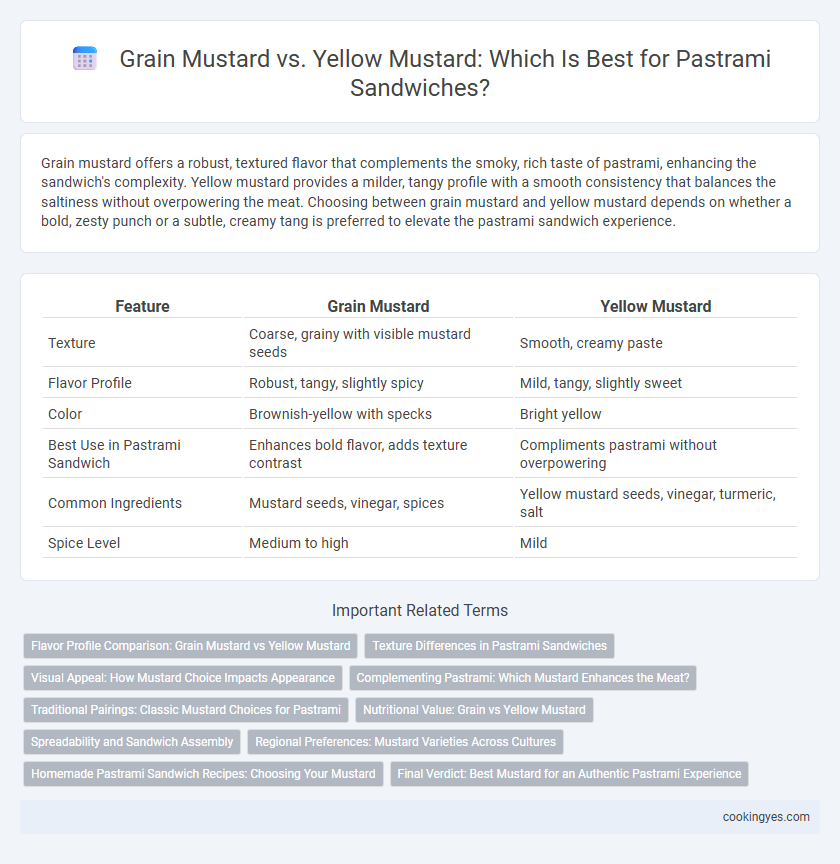Grain mustard offers a robust, textured flavor that complements the smoky, rich taste of pastrami, enhancing the sandwich's complexity. Yellow mustard provides a milder, tangy profile with a smooth consistency that balances the saltiness without overpowering the meat. Choosing between grain mustard and yellow mustard depends on whether a bold, zesty punch or a subtle, creamy tang is preferred to elevate the pastrami sandwich experience.
Table of Comparison
| Feature | Grain Mustard | Yellow Mustard |
|---|---|---|
| Texture | Coarse, grainy with visible mustard seeds | Smooth, creamy paste |
| Flavor Profile | Robust, tangy, slightly spicy | Mild, tangy, slightly sweet |
| Color | Brownish-yellow with specks | Bright yellow |
| Best Use in Pastrami Sandwich | Enhances bold flavor, adds texture contrast | Compliments pastrami without overpowering |
| Common Ingredients | Mustard seeds, vinegar, spices | Yellow mustard seeds, vinegar, turmeric, salt |
| Spice Level | Medium to high | Mild |
Flavor Profile Comparison: Grain Mustard vs Yellow Mustard
Grain mustard offers a robust, tangy flavor with a coarse texture that complements the savory, spiced notes of pastrami, enhancing each bite with bursts of sharpness. Yellow mustard provides a milder, slightly sweet taste with a smooth consistency that balances the rich, smoky flavors without overpowering the sandwich. Choosing grain mustard intensifies the sandwich's complexity, while yellow mustard maintains a harmonious, classic profile.
Texture Differences in Pastrami Sandwiches
Grain mustard offers a coarse, crunchy texture that complements the soft, tender slices of pastrami, adding a satisfying bite to each sandwich. Yellow mustard, in contrast, has a smooth, creamy consistency that blends seamlessly with the meat, providing a milder, less textured experience. Choosing grain mustard enhances the overall mouthfeel and adds a complex, tactile element to pastrami sandwiches.
Visual Appeal: How Mustard Choice Impacts Appearance
Grain mustard enhances the visual appeal of pastrami sandwiches with its coarse texture and visible mustard seeds, adding a rustic and artisanal look that contrasts beautifully against the dark, cured meat. Yellow mustard offers a smooth, bright yellow layer that provides a clean, uniform color, making the sandwich appear more vibrant and classic. Choosing between the two affects the overall presentation, with grain mustard lending a gourmet feel while yellow mustard delivers a bold, traditional aesthetic.
Complementing Pastrami: Which Mustard Enhances the Meat?
Grain mustard offers a robust, tangy flavor with coarse mustard seeds that complement the rich, smoky taste of pastrami, enhancing its savory profile without overpowering it. Yellow mustard provides a milder, slightly sweet and vinegary taste that balances the saltiness of pastrami, making it a classic choice for a more subtle mustard flavor. For a pastrami sandwich, grain mustard intensifies the meat's complexity, while yellow mustard delivers a smoother, complementary contrast.
Traditional Pairings: Classic Mustard Choices for Pastrami
Grain mustard offers a robust, tangy flavor with visible mustard seeds that complement the rich, smoky taste of pastrami, enhancing its savory profile in traditional deli sandwiches. Yellow mustard provides a milder, slightly sweet mustard flavor with a smooth texture, balancing the spiced meat without overpowering it, making it a staple in classic New York-style pastrami sandwiches. Both mustards maintain cultural authenticity, with grain mustard favored in artisanal deli preparations and yellow mustard common in fast-casual settings.
Nutritional Value: Grain vs Yellow Mustard
Grain mustard contains whole mustard seeds, providing higher fiber content and a richer source of antioxidants compared to yellow mustard, which is typically smoother and made with milder white mustard seeds. Yellow mustard often contains added vinegar, turmeric, and sugar, resulting in lower calorie content but fewer micronutrients than grain mustard. For pastrami sandwiches, grain mustard offers enhanced nutritional benefits including better digestive health support and anti-inflammatory compounds.
Spreadability and Sandwich Assembly
Grain mustard offers a coarser texture that adds a robust, tactile element to pastrami sandwiches, enhancing each bite with crunchy mustard seeds that complement the meat's richness. Its thicker consistency requires careful spreading to ensure even coverage without tearing delicate rye or pumpernickel bread. Yellow mustard's smooth, creamy texture allows for effortless spreading, creating a thin, uniform layer that integrates seamlessly into sandwich assembly and balances pastrami's bold flavors.
Regional Preferences: Mustard Varieties Across Cultures
Grain mustard, favored in European regions like Germany and France, offers a robust, textured flavor that complements the rich, smoky notes of pastrami sandwiches. Yellow mustard, popular in American deli traditions, provides a milder, tangy taste with a smooth consistency that balances the saltiness of the meat. Regional preferences highlight how grain mustard's coarse seeds deliver a rustic authenticity in Old World cultures, while yellow mustard's bright hue and subtle sharpness dominate North American pastrami sandwich recipes.
Homemade Pastrami Sandwich Recipes: Choosing Your Mustard
Grain mustard offers a robust texture and tangy flavor that enhances the rich, smoky taste of pastrami, making it ideal for homemade pastrami sandwiches. Yellow mustard provides a milder, slightly sweet profile that complements pastrami without overpowering the meat's natural flavors. Selecting between grain mustard and yellow mustard depends on whether you prefer a bold, textured bite or a smooth, classic mustard experience in your pastrami sandwich.
Final Verdict: Best Mustard for an Authentic Pastrami Experience
Grain mustard offers a robust, tangy flavor with visible mustard seeds that enhance the texture and complement the rich, smoky pastrami perfectly. Yellow mustard provides a milder, slightly sweet taste and smooth consistency, which may appeal to those seeking a subtler mustard presence. For an authentic pastrami experience, grain mustard is the best choice due to its bold flavor profile that balances the savory meat.
Grain mustard vs yellow mustard for pastrami sandwiches Infographic

 cookingyes.com
cookingyes.com